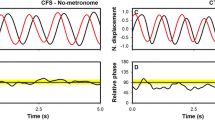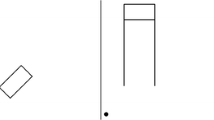Abstract
Traditional approaches to research on bimanual coordination focus on sensorimotor interference, motor programming, and effects of perception and feedback guidance; surprisingly, little is known about high-level conceptual constraints that might unify separate movements into coordinated actions. We investigated two possible forms of high-level unifying representations on anticipatory control (i.e., reaction time: RT) in two-limb (bimanual) movements. Specifically, we adapted a paradigmatic bimanual task involving reaching to targets by adding two novel manipulations. One involved a visual-perceptual manipulation in which target-objects were presented either separately (i.e., two circles) or as a unified object (i.e., two circles connected by a bar). The other involved variants on language representation to elicit separate action plans (i.e., separate instructional commands joined by ‘and’) or unified action plans (i.e., a single verb applying to both hands). Typical forms of sensorimotor interference were virtually abolished when these unifying constraints were available. These findings provide strong support for the theoretical account that unifying conceptual representations are primary forms of bimanual constraint. Findings further suggest that the organization and content of the language used to form action representations can strongly influence anticipatory planning of bimanual actions.




Similar content being viewed by others
Notes
Here, we use the term ‘representation’ in a rather general form. Our view is that representations of actions initially develop through interactions of the actor (agent), environment, task, and situation. Thus, perceptual symbols closely aligned with action representations are in this sense modal, in line with recent views of embodied cognition (Glenberg and Kaschak 2002). We view representations created from the use of arbitrary symbols (i.e., a letter representing what action to make) as reflecting further adaptations of basic representational faculties of the brain.
References
Amazeen PG, Amazeen EL, Turvey MT (1998) Breaking the reflectional symmetry of interlimb coordination dynamics. J Mot Behav 30(3):199–216
Amazeen EL, Ringenbach SD, Amazeen PG (2005) The effects of attention and handedness on coordination dynamics in a bimanual Fitts’ law task. Exp Brain Res 164:484–499
Bernstein N (1967) The co-ordination and regulation of movement. Pergamon Press, London
Cardoso de Oliveira S (2004) Control is good; prediction is better? J Mot Behav 36:375–378
Carson RG, Riek S (1998) The influence of joint position on the dynamics of perception–action coupling. Exp Brain Res 121:103–114
Diedrichsen J, Hazeltine E, Kennerley S, Ivry RB (2001) Moving to directly cued locations abolishes spatial interference during bimanual actions. Psychol Sci 12:493–498
Fitts PM (1954) The information capacity of the human motor system in controlling the amplitude of movement. J Exp Psychol 47:381–391
Franz EA (1997) Spatial coupling in the coordination of complex actions. Q J Exp Psychol A 50A:684–704
Franz EA (2003) Bimanual action representation: a window to human evolution. In: Johnston-Frey S (ed) Taking action: cognitive neuroscience perspectives on the problem of intentional acts. MIT Press, Cambridge, pp 259–288
Franz EA (2004a) Attentional distribution of task parameters to the two hands during bimanual performance of right- and left-handers. J Mot Behav 36:71–81
Franz EA (2004b) On the perceptual control of bimanual performance. J Mot Behav 36:380–381
Franz EA (2010) A framework for conceptual binding of bimanual actions: possible applications to neurology and neuro-rehabilitative therapies. Curr Trends Neurol (in press)
Franz EA, Packman T (2004) Fooling the brain into thinking it sees both hands moving enhances bimanual spatial coupling. Exp Brain Res 157:174–180
Franz EA, Ramachandran VS (1998) Bimanual coupling in amputees with phantom limbs. Nat Neurosci 1(6):443–444
Franz EA, Zelaznik H, McCabe G (1991) Spatial topological constraints in a bimanual task. Acta Psychol 77:137–151
Franz EA, Eliassen J, Ivry R, Gazzaniga MS (1996) Dissociation of spatial and temporal coupling in the bimanual movements of callosotomy patients. Psychol Sci 7:306–310
Franz EA, Waldie KE, Smith MJ (2000) The effect of callosotomy on novel versus familiar bimanual actions: a neural dissociation between controlled and automatic processes? Psychol Sci 11:82–85
Franz EA, Zelaznik HN, Swinnen S, Walter C (2001) Spatial conceptual influences on the coordination of bimanual actions: when a dual task becomes a single task. J Mot Behav 33(1):103–112
Glenberg AM, Kaschak MP (2002) Grounding language in action. Psychon Bull Rev 9(3):558–565
Goodman D, Kelso JAS (1980) Are movements prepared in parts? Not under compatible (naturalized) conditions. J Exp Psychol Gen 109:475–495
Guiard Y (1987) Asymmetric division of labor in human skilled bimanual action: the kinematic chain as a model. J Mot Behav 19:486–517
Heuer H (1993) Structural constraints on bimanual movements. Psychol Res Psychol Forsch 55(2):83–98
Jackson JH (1932) Epilepsy and epileptiform convulsions. In: Taylor J (ed) Selected writings of John Hughlings Jackson, vol 2. Hodder and Stoughton, London, pp 3–92
Kelso JAS, Southard DL, Goodman D (1979) On the nature of human interlimb coordination. Science 203:1029–1031
Li Y, Levin O, Carson RG, Swinnen SP (2004) Bimanual coordination: constraints imposed by the relative timing of homologous muscle activation. Exp Brain Res 15:27–38
Marteniuk RG, MacKenzie CL, Baba DM (1984) Bimanual movement control: information processing and interaction effects. Q J Exp Psychol 36A:335–365
Mechsner F, Kerzel D, Knoblich G, Prinz W (2001) Perceptual basis of bimanual coordination. Nature 414:69–73
Obhi SS, Goodale M (2005) Bimanual interference in rapid discrete movements is task specific and occurs at multiple levels of processing. J Neurophysiol 94:1861–1868
Obhi SS, Haggard P (2004) The relative effects of external spatial and motoric factors on the bimanual coordination of discrete movements. Exp Brain Res 154:399–402
Oldfield RC (1971) The assessment and analysis of handedness: the Edinburgh inventory. Neuropsychologia 9:97–113
Pulverműller F (2005) Brain mechanisms linking language and action. Nature 6:576–582
Riek S, Tresilian JR, Non-Williams M, Coppard VK, Carson RG (2003) Bimanual aiming and overt attention: one law for two hands. Exp Brain Res 153:59–75
Spijkers W, Heuer H (1995) Structural constraints on the performance of symmetrical bimanual movements with different amplitudes. Q J Exp Psychol A 48:716–740
Spijkers W, Heuer H, Kleinsorge T, van Der Loo H (1997) Preparation of bimanual movements with same and different amplitudes: specification interference as revealed by reaction time. Acta Psychol 96:207–227
Stucchi N, Viviani P (1993) Cerebral dominance and asynchrony between bimanual two-dimensional movements. J Exp Psychol Hum Percept Perform 19:1200–1220
Weigelt C, Cardoso de Oliviera S (2003) Visuomotor transformations affect bimanual coupling. Exp Brain Res 148:439–450
Wing AM, Flanagan JR (1997) Anticipating dynamic loads in handling objects, DSC-Vol 64. Proceedings of the ASME dynamic systems and control division, ASME, 1998, pp 139–143
Wing AM, Lederman S (1998) Anticipating load torques produced by voluntary movements. Percept Perform Hum Percept Perform 24:1571–1581
Author information
Authors and Affiliations
Corresponding author
Rights and permissions
About this article
Cite this article
Franz, E.A., McCormick, R. Conceptual unifying constraints override sensorimotor interference during anticipatory control of bimanual actions. Exp Brain Res 205, 273–282 (2010). https://doi.org/10.1007/s00221-010-2365-5
Received:
Accepted:
Published:
Issue Date:
DOI: https://doi.org/10.1007/s00221-010-2365-5




